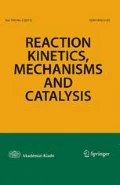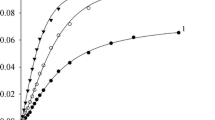Abstract
The kinetics of the reaction of epichlorohydrin ((2-chloromethyl)oxirane) with acetic acid at 60 °C was studied in the presence of the catalyst—tetrabutylammonium iodide either in epichlorohydrin, or a binary solvent epichlorohydrin:tetrahydrofuran. The ratios of the binary solvent components were selected in order to preserve the excess of epichlorohydrin as the condition for pseudoorder with respect to the oxirane reactant. As the order of the reaction with respect to acid may differ depending on the reaction series, it was determined by kinetic and modelling methods. The correlation between solvent permittivity and observed and catalytic reaction rate constants was established. The equation for predicting tetrabutylammonium iodide catalytic reactivity in the binary solvent was obtained. The effect of solvent polarity on the rate and mechanism of oxirane ring opening reaction in the presence of a base catalyst was estimated via Laidler–Eyring equation. It was shown that the decrease of solvent polarity increases the reaction rate and its regioselectivity.








Similar content being viewed by others
References
Herzberger J, Niederer K, Pohlit H, Seiwert J, Worm M, Wurm FR, Frey H (2016) Chem Rev 116(4):2170–2243. https://doi.org/10.1021/acs.chemrev.5b00441
Lee Y, Yu J, Park K, Kim GJ (2017) Bull Korean Chem Soc 38:795–803. https://doi.org/10.1002/bkcs.11174
Kobzev SP, Romantsevich AM, Simonov MA, Opeyda IO (1995) Kinet Catal 36:219–224
Shved EN, Usachov VV, Kozorezova EI (2007) Ukr Chem J 73:113–117
Aouf C, Le Guernevé C, Caillol S, Fulcrand H (2013) Tetrahedron 69(4):1345–1353. https://doi.org/10.1016/j.tet.2012.11.079
Kasyan LI, Kasyan AO, Okovytyi SI, Tarabara IN (2003) Alicyclic epoxy compounds. Oles Honchar Dnipropetrovsk National University, Dnipropetrovsk, Ukraine, Reactivity (in Russian)
Bukowska A, Bukowski W (2002) Org Process Res Dev 6(3):234–237. https://doi.org/10.1021/op010112q
Shpanko IV, Sadova IV (2006) Ukr Chem J 72:42–47
Guskov AK, Yui S, Makarov MG, Shvets VF, Bukowska A, Kozlovskyi RA (1973) Kinet Catal 14:928–932
Shvets VF, Romashkin AV, Yudina VV (1973) Kinet Catal 14:928–932
Bakhtin S, Shved E, Bespal’ko Y (2017) J Phys Org Chem 30(12). https://doi.org/10.1002/poc.3717
Goga ST, Lebed AV, Mchedlov-Petrossyan NO (2010) J Chem Eng Data 55:1887–1892
Palval IN, Lebed AV, McHedlov-Petrossyan NO (2011) J Mol Liq 158(1):33–37. https://doi.org/10.1016/j.molliq.2010.10.004
Roy MN, Sarkar L, Dewan R (2011) J Chem Thermodyn 43(3):371–376. https://doi.org/10.1016/j.jct.2010.10.008
Bukowska A, Guskov KA, Makarov MG, Rokaszewski E, Shvets VF (1995) J Chem Technol Biotechnol 63:374–378
Bukowski W (2000) Int J Chem Kinet 32(6):378–387.
Lebedev NN, Guskov KA (1963) Kinet Catal 4:116–127
Tanaka Y, Takeuchi H (1968) Tetrahedron 24:6433–6448
Ishii Y, Sakai S, Sugiyama T (1963) Bull Jpn Pet Inst 5:44–52
Armarego WLF, Chai CLL (2013) Purification of laboratory chemicals. Elsevier, Waltham
Chernov’yants MS, Gol’eva VE, Pyshchev AI (2003) J Anal Chem 58(2):139–143. https://doi.org/10.1023/a:1022302020450
Lide DR (ed) (2009) CRC handbook of chemistry and physics (2009–2010). 90th edn. CRC Press, Boca Raton
Reis JC, Iglesias TP, Douheret G, Davis MI (2009) Phys Chem Chem Phys 11(20):3977–3986. https://doi.org/10.1039/b820613a
Shologon IM, Klebanov MS, Aldoshin VA (1982) Kinet Catal 4:841–846
Shved EN (2013) Sinel’nikova MA, Bespal’ko YN. Vestn NovSU 2:64–67
Abramenkov AV (2012) KINET—a program for numerical modelling of complex chemical reactions kinetics (in Russian). http://www.chem.msu.su/rus/teaching/KINET2012. Accessed 19 Jan 2018
Palm VA (1977) Fundamentals of the quantitative theory of organic reactions. Khimiya, Leningrad (in Russian)
Acknowledgements
The study was carried out within the Fundamental Research Programme funded by the Ministry of Education and Science of Ukraine (Project No. 0116U002519).
Author information
Authors and Affiliations
Corresponding author
Electronic supplementary material
Below is the link to the electronic supplementary material.
Rights and permissions
About this article
Cite this article
Yutilova, K., Shved, E. & Shuvakin, S. Behavior of epichlorohydrin catalytic acidolysis reaction with the variation of solvent polarity. Reac Kinet Mech Cat 125, 15–24 (2018). https://doi.org/10.1007/s11144-018-1408-y
Received:
Accepted:
Published:
Issue Date:
DOI: https://doi.org/10.1007/s11144-018-1408-y



